A Taste of Puglia
For the holidays this month we celebrate Puglia. If Italy is the boot, Puglia is the heel, extending along the coast of the Adriatic Sea from the Gargano Peninsula around to the Ionian Sea and the Gulf of Taranto. It is a land of olive trees and beaches and memorable cheeses, Romanesque churches and small ports, the round stone trulli huts of the Murgia. I have recently returned from my buying trip and we have filled the shops with all good things from the region.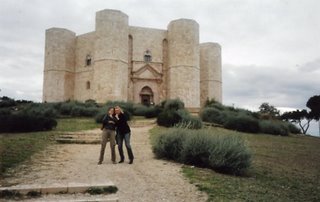 Castel Del Monte - Puglia's Most Famous Monument
Castel Del Monte - Puglia's Most Famous Monument
In the town of Corado we visit Giuseppe del Console, the genius of oil, whom I’d met a decade before. He takes the best coratina olives and presses them in the old fashioned way, gently squeezing the fruit to produce the most aromatic of oils; low in acidity with a very strong flavor, an intense fruitiness with a smell of artichokes and burnt almonds. This is the oil that burns the back of your throat, a searing hotness I love when the oil called for must match the intensity of the food. This extra virgin has the highest levels of polyphenols, whose antioxidant properties are far from the mellower oils further north. Giuseppe advises us to use but a little though I never do.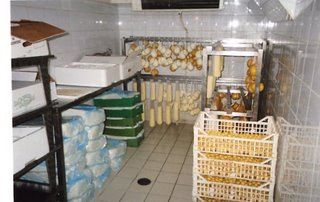 The Backroom of a Local Cheese Shop
The Backroom of a Local Cheese Shop
We visit Antonio Fiore, a third generation taralli producer – those little round crackers that to me are superior to all other crackers. It is easy to see why: made only of the best flour (farina di grano tenero, a soft wheat flour), white wine, and extra virgin oil, they crumble in your mouth. No risk here of crackers full of transfats. I buy many flavors, including fennel and pizza, whole wheat and onion, knowing Frankie and the boys back home will like these. In the 17th century they substituted for bread, and were eaten with wild chicory and bitter broccoli served with oil. This is part of what they call ‘la cucina povera', for the cuisine of Puglia is the cuisine of poverty.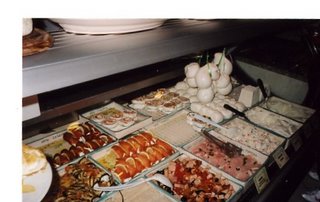 The Cheese Case in Andria
The Cheese Case in Andria
A poor land, invaded over and over, century after century, this means pasta made without eggs; bread from the hard grain durum wheat; many vegetables but little meat; local sautéed olives and cippoline agridolce, sweet and sour; fish eaten crudo or fried in oil; and fava beans with cooked potato. And of course the cheese: fresh ricotta and the best mozzarella in the world, creamy burrata, scamorza fat and smoked; and then more seafood: gamberone and pulpi, grilled or raw.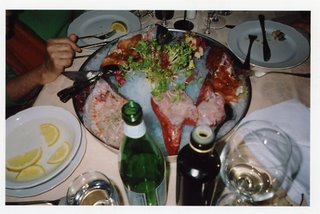 Dinner at the Local Seafood Restaurant
Dinner at the Local Seafood Restaurant
We stop for lunch with our friends Roberto, Sabina and Cinzia at Antichi Sapori, where the great chef Pietro Zito serves us splendid plate after plate: caciacavello with candied apples; pecorino with red onion; whole fried onions like small flowers; leeks with chili and stuffed artichokes. How this small place in the small village of Monte Grasso has become a veritable I Bulli of the region is no mystery. Pietro is so busy he closes Saturday night. We taste his scamorza di capra-goat milk scamorza aged in his cave-and I order some for my shops.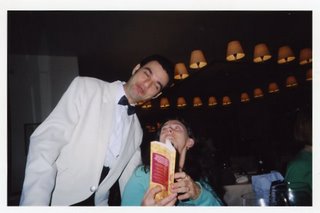 Borat, The Waiter
Borat, The Waiter
After lunch we visit a biomasserina, an organic working farm overlooking the sea, and agriturismo with ten perfect rooms. We promise to return here, to eat outside on the terrace surrounded by fig and olive trees, the ancient structures restored with hand chiseled blocks of Murgia stone, the white gray stones made famous in the Castel del Monte and the Romanesque masterpiece in nearby Trani. It is called the Lama di Luna, sliver of the moon, and here one can rest in peace.
At Giovanni Mucci’s chocolate factory we taste the artisan chocolates his family has produced for four generations, the antica fabbrica di confetti. The family is so famous they run a candy museum in nearby Andria. Only the finest ingredients are used here: chocolate from Belgium; pistachios from Bronte, in Sicily; and teneralli, the local almonds from nearby Bari. I order a dozen flavors to put in glass jars behind the counter, to scoop into little bags for a holiday treat for my customers—espresso with liquid centers, and liquorice, and limoncello. All these are sugar coated in great ancient vats, a mere 200 grams of sugar to coat 60 kg of candy. I have a small sample bag here on my desk as I write. A Street Mime in Lecce
A Street Mime in Lecce
On the flight home, I think of the great emperor Frederick II -the emperor known as stupor mundi, “the astonishment of the world”- and what he built in Puglia during the 13th century, when the region was at its height. I think of how he learned math and poetry, architecture and astronomy, and I wonder why the world seems small now. How Frederick reached out to the Jews and admired the Muslims for their advanced civilization, and wonder what will become of things. 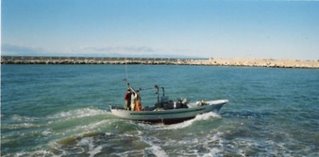 A Fishing Boat Heads Out on The Adriatic
A Fishing Boat Heads Out on The Adriatic
But my own needs have been well met; I have met some wonderful people, and eaten their finest foods: the ricotta forte and cimi di rapa; orichiette drizzled with oil; pane di altimurra, the yellow semolina bread with the hard crust, dunked in many different oils; and the cardoncelli mushrooms now in season. We have eaten with the great food writer Nancy Harmon Jenkins, mother of our friend and chef Sara back home. We have visited the small producer of raw milk burrata in Andria, and tasted rucola spread on crostini made with wild arugula and pecorino. Now it is time to return and bring these things home, and hope our luggage is not lost again.
-Rob Kaufelt
Proprietor
Murray's Cheese



<< Home